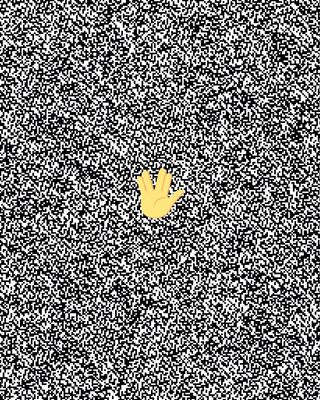New alliance? [Nowe porozumienie?]
Dorota Michalska's manifesto, New alliance? [Nowe porozumienie?] in the form of a booklet designed by Maciej Ratajski was published on September 23rd, 2016 during Osiedle Młodych art intervention. The intervention/exhibition curated by Andrzej Pakuła took place at Zespół Szkół Mistrzostwa Sportowego na Osiedlu Tysiąclecia — a sports school in Poznań built during the Socialist era to commemorate The Millenary of Polish State.
The manifesto release was accompanied by an interactive installation by Ratajski. Using only objects available at the school's library — old computers, LCD TV etc., Ratajski presented Michalska's text as a sound installation, an app for word-by-word quick reading, a digital booklet, a video performance of Agnieszka Szostakiewicz reading the whole text of the manifesto while skipping rope (Skipping Rhyme [Skakanka]) and videos of Maja Rozbicka performing downward dog yoga position at the Palace of Culture and Science in Warsaw.
In her text, Michalska argues that artists should look for new frameworks for thinking and describing contemporary times and leave behind tools like linear text and strategies used by artists representing the critical art movement in Poland (Sztuka krytyczna). According to Michalska, artists should work on new languages and alternative forms of communication that would reach young people — including through body, new media and new technologies.
The booklet with Dorota Michalska's manifesto (in Polish) is available here and as a PDF download.
Skipping Rhyme [Skakanka]
Skipping Rhyme [Skakanka], Maciej Ratajski’s work performed by Agnieszka Szostakiewicz is a video performance lasting 16 minutes created in response to Dorota Michalska’s manifesto New alliance? [Nowe porozumienie?]. Szostakiewicz — performer and art historian — reads Michalska’s text, jumping with a rope against the backdrop of a bookcase.
Michalska’s manifesto raises the question of the possibility of forging a new alliance between contemporary artists and young people and postulates the need to find alternative ways of communicating with the new generation — in the face of shortcomings of the linearity of written text and the outdated strategies of critical art.
Skakanka is associated with both youth and fun, as well as with sports. The fragmented text recited rhythmically, word by word by Szostakiewicz may sound like the shouts of a manifesting crowd, melorecitation or — especially in this context — like a skipping rhyme.
The performance is a literal response to the postulate of searching for new forms of perception and communication in non-discursive body practices and the “culture of hybrid bodies” — self-aware and intensely, physically feeling the world around them.
Poorly chosen length of the ski jump, poor condition and lack of sports experience of the performer (art research is more about studying theory than body practice) and the very nature of the task result in fatigue, and shortness of breath. Mistakes, misinterpretations and omissions in reading start to appear.
As a result, the parts of the text about exhaustion (of the critical strength of existing tools) and the inability to keep up (with the technological acceleration) seem to leave the strongest impact. The body is subjected to the oppression of the text rather than treated as a source of pleasure. Such form of performance can easily be associated with the critical art strategies opposed by Michalska. Her demands delivered in this way may sound even more like a desperate last call made with the last strength.
![New alliance? [Nowe porozumienie?] interactive art intervention in a school library during Osiedle Młodych in Poznań.](/img/maciej-ratajski-2016-09-23-osiedle-mlodych-2-320.jpeg)
![New alliance? [Nowe porozumienie?] interactive art intervention in a school library during Osiedle Młodych in Poznań.](/img/maciej-ratajski-2016-09-23-osiedle-mlodych-320.jpeg)
![Booklet cover of New alliance? [Nowe porozumienie?] manifesto by Dorota Michalska published during Osiedle Młodych art intervention in Poznań, 2016. The whole text of Michalska's manifesto was encoded to binary and represented as white and black squeres on the cover. The title was represented as a QR code.](/img/maciej-ratajski-2016-09-23-nowe-porozumienie-cover-320.jpeg)
![Spread from New alliance? [Nowe porozumienie?] booklet designed by Maciej Ratajski.](/img/maciej-ratajski-2016-09-23-nowe-porozumienie-spread-1-320.jpeg)
![Spread from New alliance? [Nowe porozumienie?] booklet designed by Maciej Ratajski.](/img/maciej-ratajski-2016-09-23-nowe-porozumienie-spread-2-320.jpeg)
![Spread from New alliance? [Nowe porozumienie?] booklet designed by Maciej Ratajski.](/img/maciej-ratajski-2016-09-23-nowe-porozumienie-spread-3-320.jpeg)
![Spread from New alliance? [Nowe porozumienie?] booklet designed by Maciej Ratajski.](/img/maciej-ratajski-2016-09-23-nowe-porozumienie-spread-4-320.jpeg)
![Spread from New alliance? [Nowe porozumienie?] booklet designed by Maciej Ratajski.](/img/maciej-ratajski-2016-09-23-nowe-porozumienie-spread-5-320.jpeg)
![Spread from New alliance? [Nowe porozumienie?] booklet designed by Maciej Ratajski.](/img/maciej-ratajski-2016-09-23-nowe-porozumienie-spread-6-320.jpeg)
